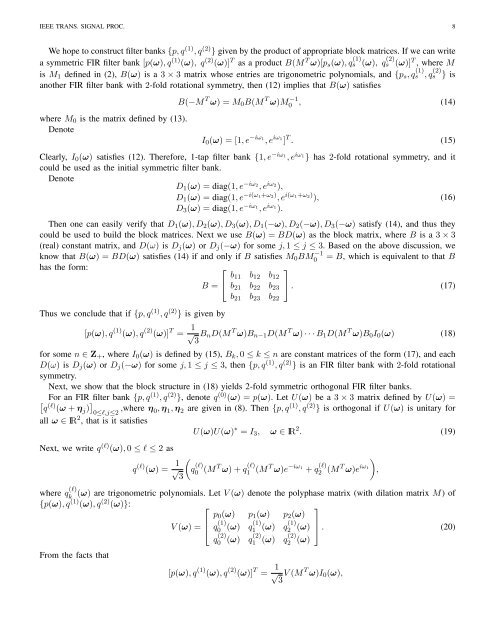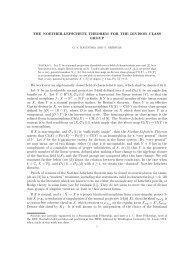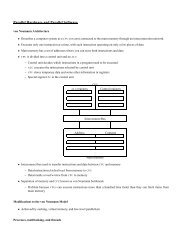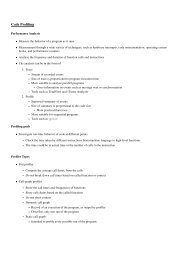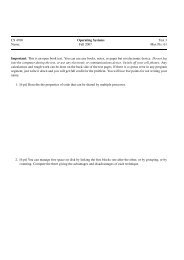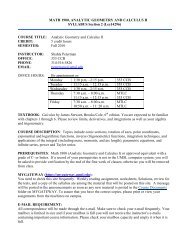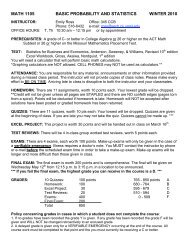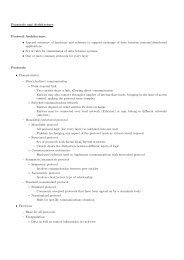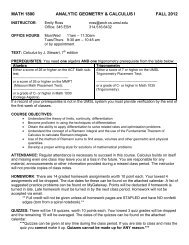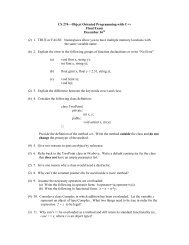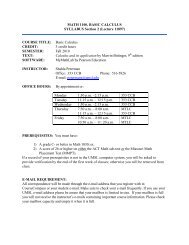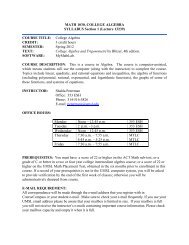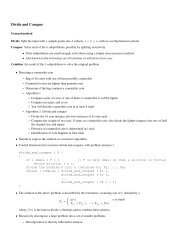here - UMSL : Mathematics and Computer Science - University of ...
here - UMSL : Mathematics and Computer Science - University of ...
here - UMSL : Mathematics and Computer Science - University of ...
Create successful ePaper yourself
Turn your PDF publications into a flip-book with our unique Google optimized e-Paper software.
IEEE TRANS. SIGNAL PROC. 8<br />
We hope to construct filter banks {p, q (1) , q (2) } given by the product <strong>of</strong> appropriate block matrices. If we can write<br />
a symmetric FIR filter bank [p(ω), q (1) (ω), q (2) (ω)] T as a product B(M T ω)[p s (ω), q s (1) (ω), q s<br />
(2) (ω)] T , w<strong>here</strong> M<br />
is M 1 defined in (2), B(ω) is a 3 × 3 matrix whose entries are trigonometric polynomials, <strong>and</strong> {p s , q s (1) , q s<br />
(2) } is<br />
another FIR filter bank with 2-fold rotational symmetry, then (12) implies that B(ω) satisfies<br />
w<strong>here</strong> M 0 is the matrix defined by (13).<br />
Denote<br />
B(−M T ω) = M 0 B(M T ω)M −1<br />
0 , (14)<br />
I 0 (ω) = [1, e −iω1 , e iω1 ] T . (15)<br />
Clearly, I 0 (ω) satisfies (12). T<strong>here</strong>fore, 1-tap filter bank {1, e −iω 1 , eiω 1<br />
} has 2-fold rotational symmetry, <strong>and</strong> it<br />
could be used as the initial symmetric filter bank.<br />
Denote<br />
D 1 (ω) = diag(1, e −iω2 , e iω2 ),<br />
D 1 (ω) = diag(1, e −i(ω 1+ω ) 2<br />
, e i(ω 1+ω ) 2<br />
),<br />
(16)<br />
D 3 (ω) = diag(1, e −iω 1 , eiω 1 ).<br />
Then one can easily verify that D 1 (ω), D 2 (ω), D 3 (ω), D 1 (−ω), D 2 (−ω), D 3 (−ω) satisfy (14), <strong>and</strong> thus they<br />
could be used to build the block matrices. Next we use B(ω) = BD(ω) as the block matrix, w<strong>here</strong> B is a 3 × 3<br />
(real) constant matrix, <strong>and</strong> D(ω) is D j (ω) or D j (−ω) for some j, 1 ≤ j ≤ 3. Based on the above discussion, we<br />
know that B(ω) = BD(ω) satisfies (14) if <strong>and</strong> only if B satisfies M 0 BM0 −1 = B, which is equivalent to that B<br />
has the form:<br />
⎡<br />
⎤<br />
b 11 b 12 b 12<br />
B = ⎣ b 21 b 22 b 23<br />
⎦ . (17)<br />
b 21 b 23 b 22<br />
Thus we conclude that if {p, q (1) , q (2) } is given by<br />
[p(ω), q (1) (ω), q (2) (ω)] T = 1 √<br />
3<br />
B n D(M T ω)B n−1 D(M T ω) · · · B 1 D(M T ω)B 0 I 0 (ω) (18)<br />
for some n ∈ Z + , w<strong>here</strong> I 0 (ω) is defined by (15), B k , 0 ≤ k ≤ n are constant matrices <strong>of</strong> the form (17), <strong>and</strong> each<br />
D(ω) is D j (ω) or D j (−ω) for some j, 1 ≤ j ≤ 3, then {p, q (1) , q (2) } is an FIR filter bank with 2-fold rotational<br />
symmetry.<br />
Next, we show that the block structure in (18) yields 2-fold symmetric orthogonal FIR filter banks.<br />
For an FIR filter bank {p, q (1) , q (2) }, denote q (0) (ω) = p(ω). Let U(ω) be a 3 × 3 matrix defined by U(ω) =<br />
[<br />
q (l) (ω + η j ) ] 0≤l,j≤2 ,w<strong>here</strong> η 0, η 1 , η 2 are given in (8). Then {p, q (1) , q (2) } is orthogonal if U(ω) is unitary for<br />
all ω ∈ IR 2 , that is it satisfies<br />
U(ω)U(ω) ∗ = I 3 , ω ∈ IR 2 . (19)<br />
Next, we write q (l) (ω), 0 ≤ l ≤ 2 as<br />
q (l) (ω) = √ 1 (<br />
)<br />
q (l)<br />
0 (M T ω) + q (l)<br />
1 (M T ω)e −iω 1<br />
+ q (l)<br />
2 (M T ω)e iω 1<br />
,<br />
3<br />
w<strong>here</strong> q (l)<br />
k<br />
(ω) are trigonometric polynomials. Let V (ω) denote the polyphase matrix (with dilation matrix M) <strong>of</strong><br />
{p(ω), q (1) (ω), q (2) (ω)}:<br />
⎡<br />
p 0 (ω) p 1 (ω) p 2 (ω)<br />
⎢<br />
V (ω) = ⎣ q (1)<br />
0 (ω) q(1) 1 (ω) q(1) 2 (ω) ⎥<br />
⎦ . (20)<br />
From the facts that<br />
q (2)<br />
0<br />
(ω) q(2) 1<br />
(ω) q(2)<br />
2 (ω) ⎤<br />
[p(ω), q (1) (ω), q (2) (ω)] T =<br />
1 √<br />
3<br />
V (M T ω)I 0 (ω),


